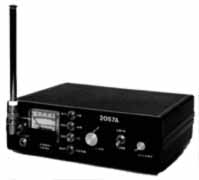

Basic Countermeasures Equipment

2057A - RF LOCATOR
The 2057A is an ultra-sensitive, 10 MHz to 2,000 MHz+ radio frequency (RF) locator with audio and visual readout. The unit detects and demodulates RF signals with narrow and wide-band frequency modulation (FM), amplitude modulation (AM) and FM or AM signals which contain double modulation/sub-carriers (SC). The 2O57A may be used in either the TUNE mode, where the locator can be manually tuned throughout its range, or in the LOCK mode, where the locator automatically locks onto the strongest signal regardless of its frequency. A narrow band-pass filter may be inserted, by a front panel switch, into the audio path to enhance feedback detection. Output can be monitored either through the internal speaker or headset supplied.
The unit is powered by a self contained, rechargeable Ni-Cad battery pack. Battery condition is indicated by the red light emitting diode (LED) above the VOLUME control If the batteries need charging, this LED will light when the unit is turned on. NOTE: If the batteries are completely discharged the LED will be very dim or fail to light and no sound will be heard from the speaker.
OPERATION... FEEDBACK/LOCK MODE: Connect the antenna to the ANTENNA jack (push on and twist one quarter turn clockwise to secure). The number of antenna sections used is a function of the ambient RF level in the sweep area. If there are many AM, FM or TV stations locally, use only the main section with all others collapsed. If there are relatively few local stations extend the next large antenna section. If the unit is operated in a rural area, three or tour sections can be used. Place the switches in FM, AM, SC, FILTER and LOCK positions. Turn the Unit on by rotating the VOLUME control clockwise from the OFF position + Advance the VOLUME until a hiss or radio station is heard from the speaker.
Grasp the case by the right side and move the 2057A throughout the area being checked, passing as close as possible to all objects i.e. chairs, lamps, desks, bookshelves, etc. If an active transmitter is detected, a feedback squeal will develop. Turn OFF the modulation type switches (FM, AM, or SC) that do not assist in the feedback process. Place the LOCK-TUNE switch in the TUNE position and slowly rotate the ten-turn TUNING control from one end of its range to the other until feedback is again established. When tuning, the same signal may be heard at several positions of the TUNING control. This is normal for the detection process used. Note the level on the SIGNAL LEVEL meter. Reduce the VOLUME until feedback stops, Proceed in the direction that causes the greatest meter indication and reestablishes feedback until the source is located.
OPERATION... HEADSET/LOCK MODE: Turn on the FM, AM and SC switches but leave the FILTER Switch in the OUT position. Plug the headset into the HEADSET jack. Set the VOLUME control for comfortable listening. Sweep all objects in the area, passing as close to each as possible. If a transmitter is located, its audio will he heard through the headset. For clearest audio, turn OFF the modulation type switches (FM, AM or SC) which do not assist in the detection proverb. Proceed in the direction that gives the strongest meter reading until the source is located.
The TUNE position of the LOCK-TUNE switch is more sensitive than the LOCK position. The unit may be taken to each corner of the search area and slowly tuned throughout its range. As mentioned earlier, the same signal may be heard at several positions of the TURNING control. This is normal for the detection process used.
The 2057A may be operated in a fixed location on a desk or table top. Use the right angle adapter supplied to make the antenna vertical.
The recharging process takes approximately 8 hours for a full charge. Make sure the charger is set at the correct input voltage, i.e. 11OVAC or 220VAC. The front selector switches have been preset at 9 volts and + out. Insert the charger into the AC power source and the jack on the back of the 2057A. The unit say be operated during the charging process. When charging is complete, remove the charger from the power source and the back of the 2057A. THE BATTERY WILL DISCHARGE BACK THROUGH THE CHARGER IF THE PLUG IS NOT REMOVED.
Self contained, rechargeable ni-cad batteries power the unit. A low battery indicator is included. A charger for use with 110/220 VAC at 50/60 Hz is supplied.
The System contains the 2057A detector, collapsible antennas right angle antenna adapter, headset, battery charger and carrying case.
Measures 2 1/2" (64 mm) high X 8" (240 mm) wide X 6" (153 mm) deep.
Weight of 2057A detector is 1 3/4 pounds (.8 Kg).
Weight in carrying case with charger is 4 pounds (1.8 Kg).
![]()
Any comments or questions regarding this specific page?
Please feel free to sign our Guest Book
![]()
|
To be contacted for a confidential consultation please E-mail: jmatk@tscm.com
or send a letter via US Mail to:
or call:
URL: http://www.tscm.com/ |